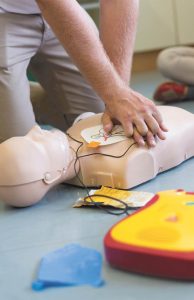By Dr. Aneley Yegezu Hundae, M.D., FACC
 Cardiopulmonary resuscitation (CPR) is a critical skill that can mean the difference between life and death in an emergency.
Cardiopulmonary resuscitation (CPR) is a critical skill that can mean the difference between life and death in an emergency.
While we hope to never find ourselves in such situations, knowing the basics of CPR can empower us to be first responders and save lives when it matters most. In this article, we’ll explore the essential aspects of CPR and provide you with the knowledge you need to make a difference in someone’s life.
Understanding the Importance of CPR
CPR is a lifesaving technique used in emergencies when someone’s heartbeat or breathing has stopped. It can occur due to various reasons, including cardiac arrest, drowning, choking, or trauma. When performed promptly and correctly, CPR helps maintain blood flow and oxygen to the vital organs, giving the victim a better chance of survival until professional medical help arrives.
Recognizing the Signs of Cardiac Arrest
The first step in administering CPR is recognizing when it’s needed. Common signs of cardiac arrest include the victim collapsing, unresponsiveness, and abnormal or absent breathing. If you encounter someone exhibiting these signs, it’s crucial to act quickly.
Call 911 Immediately
Before starting CPR, call 911 or ask someone nearby to do so. The faster professional help arrives, the better the chances of a positive outcome. Time is of the essence in emergencies like these.
The Basics of CPR
CPR primarily consists of two key components: chest compressions and rescue breaths.
Chest Compressions: Position the victim on their back on a firm surface. Kneel beside them and place the heel of one hand in the center of the chest, just below the nipple line. Use your other hand to interlock fingers and position your shoulders directly over your hands. Press down hard and fast, allowing the chest to recoil fully between compressions. Aim for a rate of 100-120 compressions per minute. This is crucial for maintaining blood circulation.
Rescue Breaths: After every 30 chest compressions, provide two rescue breaths. Tilt the victim’s head back slightly, pinch their nose closed, and cover their mouth with yours. Give a breath lasting about one second, watching for the chest to rise. If it does, continue with the second breath. If not, reposition the head and try again.
Hands-Only CPR
In some cases, especially if you are untrained or uncomfortable with rescue breaths, you can perform hands-only CPR by focusing solely on chest compressions. This is still effective and can be life-saving.
Use an Automated External Defibrillator (AED)
If an AED is available, use it alongside CPR. These devices are designed to analyze the heart’s rhythm and deliver an electric shock if necessary. Follow the AED’s prompts carefully, and resume CPR immediately afterward.
Training for CPR
While reading about CPR is valuable, it’s even better to receive hands-on training. Many organizations, such as the American Heart Association and the Red Cross, offer CPR courses. These courses provide both knowledge and practical skills, increasing your confidence and effectiveness in an emergency.
Knowing the basic principles of CPR can make you a lifesaver when time is of the essence. Remember, in an emergency, taking action is crucial. By recognizing the signs of cardiac arrest, calling 911, and applying the fundamentals of CPR, you can potentially save a life. So, take the initiative to learn CPR and be prepared to make a difference when it matters most. Your actions can be the bridge between a life lost and a life saved.
Dr. Aneley Yegezu Hundae, M.D., FACC
invasive cardiology and advanced heart failure management
Dr. Hundae received his Premedical and Doctor of Medicine Degree from Jimma University School of Medicine. He completed his Internal medicine Residency at Mercer University School of Medicine. His Heart Failure/Heart Transplant fellowship at the University of Miami Cardiovascular Fellowship Program. Cardiovascular fellowship at Baylor University Medical Center.
Board certifications
• Cardiology
• Advanced Heart Failure and Transplant
• Nuclear Cardiology
• Comprehensive Echocardiography
• Internal Medicine
Port Charlotte Cardiology
3161 Harbor Blvd, Suite A, Port Charlotte, FL 33952
(941) 235-8892
www.portcharlottecardiology.com








